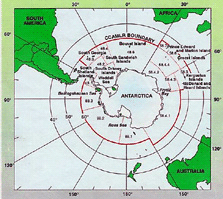The principles set down in
Article II
of the Convention require that:
(i) exploited populations shall not be allowed to fall below a level close
to that which ensures their greatest net annual increase;
(ii) ecological relationships between harvested, dependent and related
species shall be maintained and depleted populations shall be restored to
the levels defined in (i); and
(iii) risks of changes to the marine ecosystem that are not potentially
reversible over two or three decades shall be prevented or minimised.
These principles embody what has been called the ‘ecosystem approach’ to resource conservation and specifically include reference to the need for minimisation of risk in terms of irriversible changes, the ‘precautionary approach’.
These considerations set the Convention apart from other marine resource management regimes.

The area of application of the Convention is shown in the attached map; its northern boundary was chosen to approximate the Antarctic Convergence.
The Convention provides an administrative structure for its own implementation.
The Commission (Articles VII to IX) is the decision-making body, the Scientific Committee (Article XV) gathers information and advises the Commission, and a permanent Secretariat (Article XVII) supports the work of the Commission and Scientific Committee.
Article XXIII of the Convention requires that the Commission and Scientific Committee cooperate with the Antarctic Treaty Consultative Parties on matters falling within the competence of the latter.
It also requires that they cooperate as appropriate with the Food and Agriculture Organisation (FAO) of the United Nations and with other Specialised Agencies.
The Convention also stipulates that, as appropriate, special working relationships be developed by the Scientific Committee with both inter-governmental and non-governmental organisations that could contribute to its work.
Special reference is made to cooperation with the Scientific Committee on Antarctic Research (SCAR), the Scientific Committee on Oceanic Research (SCOR) and the International Whaling Commission (IWC).